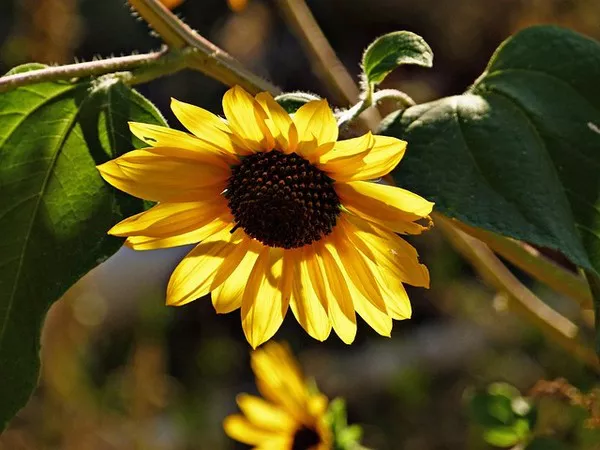Sunflowers, with their iconic golden petals and vibrant centers, are universally recognized symbols of happiness, positivity, and the warmth of summer. However, beyond the well-known image of the classic yellow sunflower lies a captivating world of diversity. From petite dwarfs to towering giants, from fiery reds to soothing creams, the varieties of sunflowers are as varied as the hues of a sunset. In this article, we embark on a journey to discover the remarkable array of sunflower varieties, each offering a unique perspective on nature’s artistry.
The Botanical Brilliance of Sunflowers
Sunflowers, scientifically known as Helianthus annuus, belong to the Asteraceae family. Native to North America, these iconic blooms have not only captured the hearts of garden enthusiasts but have also played an essential role in agriculture, oil production, and culinary traditions. While the classic sunflower boasts bright yellow petals and a dark brown center, the world of sunflower varieties stretches far beyond this conventional image.
1. Classic Sunflowers (Helianthus annuus)
The classic sunflower variety is characterized by its towering height, large flower head, and bold yellow petals surrounding a dark, almost black center known as the disk. These sunflowers can reach impressive heights of up to 16 feet, making them a stunning focal point in gardens and landscapes. The seeds of these sunflowers are commonly harvested for their oil-rich content and nutritional value.
2. Dwarf Sunflowers
In contrast to their towering relatives, dwarf sunflowers (Helianthus annuus) offer a compact and charming presence. These varieties generally reach heights of 1 to 2 feet, making them ideal for container gardening or smaller garden spaces. Despite their diminutive stature, dwarf sunflowers still feature the signature yellow petals and dark disk.
3. Red Sunflowers
Breaking away from the traditional color palette, red sunflowers introduce a captivating twist to the familiar image. Varieties such as “Moulin Rouge” showcase deep red petals that exude a sense of passion and intensity. These varieties often retain the iconic dark center, creating a striking contrast against the fiery petals.
4. Bicolor and Multicolor Sunflowers
Bicolor and multicolor sunflowers create a visual symphony of hues within a single bloom. These varieties combine various shades of yellow, orange, and even red to create intricate patterns that resemble nature’s own artwork. Varieties like “Strawberry Blonde” and “Italian White” showcase the stunning diversity of colors that sunflowers can possess.
5. Chocolate Sunflowers
Chocolate sunflowers are a true delight for the senses. With petals in shades of rich mahogany and chocolate brown, these sunflowers evoke a sense of warmth and indulgence. The dark center further enhances the cocoa-colored palette, creating an elegant and distinctive appearance.
6. Cream and White Sunflowers
In contrast to the vibrant and intense hues, cream and white sunflowers bring a sense of serenity and purity to gardens. Varieties like “Moonwalker” and “Vanilla Ice” feature soft, creamy petals that exude elegance and grace. These sunflowers are often chosen for weddings and events due to their understated yet enchanting presence.
7. Pollen-Free Sunflowers
While sunflowers are cherished for their beauty, some individuals may be sensitive to pollen. Pollen-free sunflower varieties have been developed to address this concern. These sunflowers, with their reduced pollen production, offer the same captivating appearance without triggering allergies or sensitivities.
8. Ornamental and Decorative Sunflowers
Beyond traditional gardening, ornamental and decorative sunflowers are cherished for their unique features. Varieties with unusually shaped petals, elongated centers, or distinctive growth patterns serve as captivating additions to floral arrangements, bouquets, and ornamental displays.
9. Unique Growth Patterns
Sunflowers are known for their heliotropic behavior, meaning they track the movement of the sun across the sky. However, some varieties exhibit a different growth pattern. “Teddy Bear” sunflowers, for example, have multiple stems and flower heads that create a bushy and compact appearance, making them an excellent choice for cut flower arrangements.
10. Giant Sunflowers
As the name suggests, giant sunflowers are renowned for their impressive stature. Varieties like “Russian Giant” can reach towering heights of up to 16 feet, with flower heads that span a foot or more in diameter. These giants not only capture attention but also provide a sense of awe and majesty.
Exploring the FAQs
1. Can I grow sunflowers in pots or containers?
Absolutely! Dwarf and smaller sunflower varieties are well-suited for container gardening. Choose a larger container to accommodate the root system, use well-draining soil, and provide adequate sunlight and water.
2. How do I harvest sunflower seeds?
Allow the sunflower heads to fully mature on the plant. The back of the flower head will turn from green to yellow or brown, and the seeds will plump up. Cut the head off the plant, remove the seeds by rubbing them or using a fork, and then dry them before storing.
3. Are there sunflower varieties that attract pollinators?
Yes, sunflowers are pollinator-friendly plants. Varieties with open centers, such as classic sunflowers, provide easy access to nectar and pollen for bees, butterflies, and other pollinators.
4. Can sunflowers be grown year-round?
Sunflowers are typically annual plants, meaning they complete their lifecycle within a year. However, in warmer climates, they may act as perennial plants and reseed themselves. You can sow sunflower seeds in spring for summer blooms.
5. How do I protect sunflowers from pests and diseases?
While sunflowers are relatively hardy, they can still be susceptible to pests like aphids and diseases like powdery mildew. Regularly inspect your plants, promote good air circulation, and consider using organic pest control methods if needed.
Conclusion
Sunflowers, with their myriad varieties, exemplify the boundless creativity of nature. From the classic charm of yellow petals to the mesmerizing dance of colors, each sunflower variety tells its own story. Whether you’re a seasoned gardener or a curious novice, exploring the diverse world of sunflowers offers a captivating experience that celebrates the intricate beauty of the natural world. As you embark on your sunflower journey, remember that each variety is a testament to the remarkable diversity and brilliance of the plant kingdom.


